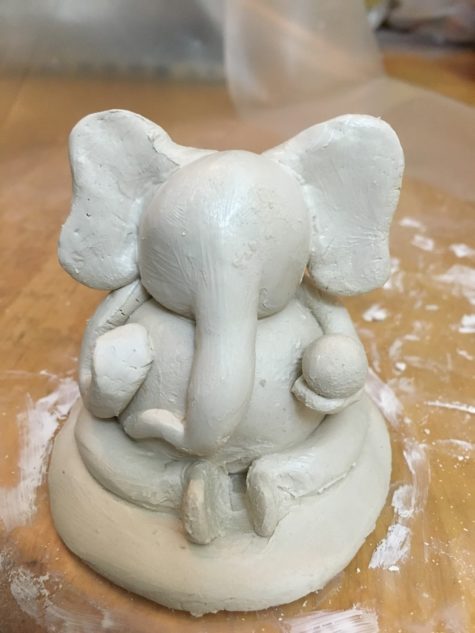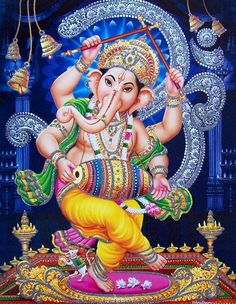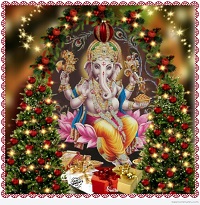Murti
Ten Rules For Placing Your Ganesha
Ganesha is one of the most important deities in Hinduism. His likeness is all over the east, and many countries — not just India — have adopted his appearance and incorporated his motifs into their culture. After all, the symbolism of Ganesha is very deep. One could even say the entire point of Ganesha is to inspire others to their highest! But even though people have decorated their homes with statues of this elephant-god, many don’t understand some of the basic rules that come with it.
Don’t forget these 10 rules when placing your Ganesha at home or work.
- Remember his Symbolism
There’s a reason why Ganesha is worshiped before undertaking new endeavors. The god of joy, happiness, and success, Ganesha has been blessing his devotees with prosperity and fortune since time immemorial. He’s thought to be the remover of obstacles, as he himself overcame lots of troubles.
- Where to Place Your Ganesha Statue
Most people are not aware there are specific places to put Ganesha to reinforce the vibration of success and happiness. According to Vastu (the science of architecture in Ayurveda), the best placement of idols is the northeast corner of the house. This is also the best location to set up the pooja room (meditation spot), as it is known as the Ishan corner.
- The White Ganesha
People seeking happiness, peace, and prosperity should bring White Ganesha home as this particular color represents purity of intention and spirituality.
- Vermillion Ganesha
Those who desire self-growth should bring a vermilion color Ganapathi statue to their home. Vermilion represents the spiritual ascendancy of mankind, and the gradual opening of the thousand-petaled lotus flower at the top of the head.
- Sitting Ganesha for the Home
The idol of sitting Ganesha is best for the house. He represents a calm, but determined demeanor- the exact kind of energy you want at home!
- The Position of the Trunk
The idol of sitting Ganesha with his trunk tilted towards his left hand should be placed in a house. It represents happiness and success. Ganesha with his trunk tilted towards his right hand is difficult to please because it represents the power of the sun which can “burn” if strict rituals are not adhered to. Better make sure your Ganesha is fat and happy!
- Standing Ganesha at Work
If you want to place Ganesha’s idol at your workplace, remember to place an idol of standing Ganesha. This brings energy and enthusiasm to work.
- The Small Details
Whenever you are placing the idol of Ganesha, remember that a mouse and modak (Indian sweet) should be a part of the statue. This is auspicious and integral to his purpose! The mouse represents material desire, which can be ridden to their completion but should never disturb inner peace. Sweets represent not getting distracted by pleasure- hence, they’re left untouched.
- One is Enough
On your altar, always keep only one idol of Lord Ganesha. Keeping two or more Ganesha idols counteracts their energy. You only need one to be effective!
- Remember the Purpose
More important than all these rules, remember the deep meaning behind Ganesha every time you see his image! He’s meant to show us the pathway to happiness, inner peace, and success in life. He’s a symbol of perseverance in the face adversity. He is like the human spirit, in the form of an idol.
Source: Sivana East
Make a Papier Mache Ganesh
 This is a simple method for a paper mache Ganesh. Some artistic ability is helpful, but if you are willing to simply get in there and have fun, it might surprise you how easy it could turn out to be!
This is a simple method for a paper mache Ganesh. Some artistic ability is helpful, but if you are willing to simply get in there and have fun, it might surprise you how easy it could turn out to be!
The materials needed are:
- Paper mache
- Latex or other water-based paint in a variety of colors
- Gold-leaf or metallic gold paint
- Paint brushes
- Sand paper
- Putty or joint compound
- Miscellaneous ornaments and cloth for dressing the image
- Replicas of the various implements he will be holding
Instructions:
- Mix paper mache to a firm but homogeneously wet consistency.
- Make an armature (skeleton) of wood, Styrofoam, or similar material.
- Create the image by covering the armature with paper mache.
- Make implements for each hand and make sure they can be inserted and glued later when the image is dry
- Brush the exterior smooth with a wet brush.
- Let the image dry in a cool place, away from the sunlight. (Drying time is usually one month for every foot in height for a clay image, three weeks for paper mache.)
- When dry, sand with coarse, then fine sandpaper
- Fill cracks with putty or joint compound.
- Sand again
- Apply a white primer and sand with very fine sandpaper.
- Make the image dust-free.
- Paint the torso, head, trunk, and limbs
- Use red paint and a fine brush for the Aum, swastika, and other – symbols.
- Paint, decorate, and/or assemble the various implements
- Place appropriate dress (traditionally white or red silk) upon the image.
- Glue the implements into the hands
- Decorate the image with ornaments, flowers, etc.
adapted from Loving Ganesa
by Satguru Sivaya Subramuniyaswami
An alternative method can be explored with this visual tutorial from Hobby Ideas:
Ganesh Chaturthi
From the Pagan Calendar, we have this great info about the Ganesh Chaturthi:
Vinayaka Chaturthi – also known as Ganesh Chaturthi – is a Hindu holiday festival that is observed on on the fourth waxing moon day during the month of Bhadrapada. This is around August or September on the Gregorian Calendar. The purpose of this festival is to honor the very popular Hindu God Ganesha, also known as Vinayaka.
- Dates vary from year to year.
- In 2018, the festival runs from September 12 thru Sept 23.
The concept of Ganesh Chaturthi is that Ganesha comes to the home of his devotees on Ganesh Chaturthi day. He brings auspiciousness, hope, success and happiness to all homes. During His brief stay, He removes all obstacles. While returning He takes with him all problems and unhappiness.
Vinayaka Chaturthi is a festival that allows people to call on the power of Ganesh and to receive help from him in removing all of the obstacles that hinder their spiritual or mental path. It is also a time to ask for help in developing spiritual strength and resolve. It is a festival of great hope, joy and celebration that can be enjoyed by everyone regardless of class or wealth.
This remains one of the most widely celebrated festivals in the Country, partly because Ganesh is one of the most popular deities for worship. Ganesha, the elephant-headed son of Shiva and Parvati, is the supreme god of knowledge, wisdom, prosperity and good fortune. He is the Lord who is first worshiped before any holy occasion or puja.
His blessings are often invoked at religious ceremonies as he is the one who can remove all obstacles to success, particularly when people are starting a new business or enterprise. Ganesh is known as the giver of fortune and one who can help to avoid natural calamities. Ganesh is also the patron god of travelling.
Lord Vinayaka is revered as the preserver of all good things and prevents Vigna (meaning obstruction/bad omen). His motto is Shubh-Laabh (good prospect and good prosperity).
The Significance of the Festival
Hindus believe that during Ganesh Chaturthi, Lord Ganesh visits his people on the earth to personally attend to their prayers. Therefore the divine energy of Lord Ganesh descends on the earth in large measures during the event. The idols of Ganesh newly bought and installed act as antennas to receive the energies of Lord Ganesh and transfer them to the people during worship. After the worship, this is why the idols specially installed for the puja are immersed marking the sendoff.
How the Ganesh Chaturthi is celebrated:
Ganesh Chaturthi is celebrated with great devotion all over India. People bring home murtis (Idols) of Lord Ganesha and celebrate the festival by worshiping the Lord in a special way for a day and a half, 3 days, 5 days, 7 days or 11 days depending on the family tradition and commitment of each individual.
In certain parts of India, such as Andhra Pradesh and Maharashtra, the festival is celebrated for ten days and is a very public occasion. Elsewhere it may celebrated in homes, where hymns are sung and offerings made to Ganesh. Sweets are a common offering as Hindu legend has it that Ganesh liked them. On the last day of worship the idol is taken out in a colorful and musical procession to be immersed traditionally at a beach.
Rituals during the festival include:
- Pranapratishhtha – the process of infusing the deity into a murti or idol.
Several months before the start of Vinayaka Chaturthi, a large clay statue of Ganesha is crafted. There is no set size limit for this murti, it can be smaller than an inch or be over twenty feet tall, depending on the person making it. This murti is then either placed in homes or set up in specially made tents so that people can pay respect to it.
If you are interested in making one of your own, here’s a link to a short simple tutorial on how to make one out of paper mache. Some artistic ability is helpful but not required. Make A Paper Mache Ganesh
Ganesh Chaturthi starts with the installation of these Ganesh statues in colorfully decorated homes and specially erected temporary structures mantapas (pandals or colorful temporary shrines) in every locality. The mantapas are decorated specially for the festival, either by using decorative items like flower garlands, small banana saplings, lights, etc or are theme based decorations, which depict religious themes or current events.
The statues are worshiped with families and friends. The priest, usually clad in red silk dhoti and shawl, then invokes life into the statue amidst the chanting of mantras. This ritual, also known as Pranapratishhtha, is done to breathe life into the idol.
- Shhodashopachara – 16 forms of paying tribute to Ganesha.
After life is breathed into the image of Ganesh, people pay respect to the murti by offering it all kinds of different items. The offerings include 21 durva (trefoil) blades of grass, red flowers, coconut, jaggery, 21 modakas. The statue is anointed with Kumkum and Sandalwood paste. Vedic hymns from the Rig Veda, the Ganapati Atharva Shirsha Upanishad, and the Ganesha stotra from the Narada Purana are chanted.
For the next ten days, the statue is worshiped.
- Uttar Puja – saying farewell before the murti is moved.
Uttar Puja is performed in order to provide a farewell to Lord Ganesh just before the immersion. Here is the step by step procedure of Uttar Puja.
Light a lamp near the idol and decorate the idol with flowers. The puja will consist of offering Achamaniyam (water to drink), Sankalp (determination), chandanarpan (sandal paste), pushpa puja (puja with flowers), Durvarpan (offering durva grass), dhopp and deep darshan (offering incense and camphor light), Nivedan (offering some dishes and fruits). Say the prayers, chant Ganesh mantras and then do arati. Then do namaskar and move the idol a little with your right hand to mark the conclusion of uttar puja.
- Ganpati Visarjan – immersion of the idol in the river.
On the eleventh day, after the Uttar puja, the Ganesh idols are taken in procession with a huge fanfare to the water bodies. The crowds shout the names of Ganesh in ecstasy and make the procession a colorful and vibrant event. The idols taken in the procession are of different sizes, models and colors. They are carried through the streets for all to see. When this has concluded, people once again pay homage one last time before they are taken to the river and submersed.
The divine energies in the idols are transferred to the waters and then to the larger world. Therefore through the process of Visarjan, three objectives of the devotees are fulfilled namely saying thanks to Ganesh for the favors received, giving a sendoff to the Lord and sending the divine powers of the Lord for the benefit of all.
The idols are immersed one by one in the waters either manually or with the help of a crane. Usually, curd rice or puffed rice is made a bundle and sent along with the idol as a mark of giving food for the deity to have while journeying. After the visarjan, some sand is collected from the spot and sprinkled around the home.
- Alternatively:
Many of the Ganesh idols will be placed outside under Bodhi Trees (Sacred Fig). The Bodhi tree is revered as a great source of remedies and is used to treat up to 50 different ailments. It also has a unique ability in that it can produce Oxygen at night-time instead of Carbon Dioxide. These healthy aspects of the tree make it a popular place for people to go to worship, as it is seen a great healer to naturally cure illnesses.
Performing A Puja At Home:
Every Hindu puja starts with the invocation of God in the object of worship in order to accept the puja and prayers. After the puja, there is a ritual called ‘Yathasthan’ meaning giving a sendoff to the deity worshiped. This is the spirit and logic behind Ganesh Visarjan also. Spiritually, this process prepares a man to move from the form to the formless state of God.
Here are the things which you will need for Ganesh Chaturthi Puja.
- An idol of Lord Ganesh.
- Chandan or sandalwood paste.
- Red flowers, preferably Hibiscus flowers.
- Incense sticks.
- Durva grass.
- Modakas (here’s a recipe) or any sweet made at home after taking bath and without having any food.
- Some fruits.
- A Chaurang or elevated table to place the idol.
- A cloth to cover the table and things to decorate it like lights.
- Diya to light in front of the idol for Aarti.
Preparation for Ganesh Chaturthi Puja at Home
Sweep and wipe clean your house. Bring the idol of Ganesh at home and you can invite your friends and relatives for the Puja. Let your entire family gather at the time of Puja. Recite Ganesh Shlokas to welcome the Lord in your house.
Many families invite Pandits or Brahmins to do Ganesh Chaturthi Puja at home so that they can perform the Puja of Lord Ganesh the right way. For any Puja or Vrat you need two things – cleanliness and devotion. This will help you get the blessings of Lord Ganesh.
- Clean your house and take bath. Wear fresh clothes and get ready for the puja.
- Prepare the Ganesh mandap with coconut or banana leaves. You can use mango leaves and flowers also to decorate it. Some decorate it with leaves of the Ashoka tree.
- A pot filled with water and rice is installed near the idol of Lord Ganesh.
- Now place the idol of Lord Ganesh saying ‘Om Ganeshay Namah’.
- Start the Puja by chanting 108 names of Lord Ganesh or chant simple Ganesh mantras.
- Light the Diya or lamp and offer Aarti to the Lord by singing hymns especially dedicated to Ganesh or Ganesh Aarti.
- Offer Naivaidya of special recipes and fruits to Ganesh Jee.
There is a significance of number 21 in this Puja and so people offer 21 Durva grass blades and 21 Modaks. 21 signify – 5 organs of perception, 5 organs of action, 5 vital airs, 5 elements and the mind.
However, when you are performing Ganesh Chaturthi Puja at home you can be flexible. All you need to have is clean body and mind and the thing that is most important is devotion and not the ritual. So, try to keep things simple and concentrate on the Puja.
























